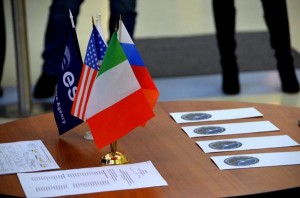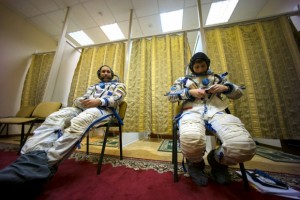L-1: Last one on Earth
Saturday
15:26
Well, this is likely my last countdown logbook (or maybe the second last). Over two weeks ago I told you about our final exams in Star City. In the meantime, the countdown is almost down to zero and it will be soon time to start counting up… from orbit!
Just to give you a few (mainly visual) impressions from the past few weeks:
… back in Moscow we participated in the traditional visit to the Gagarin’s tomb on the Red Square, after a press conference and a visit to Yuri Gagarin’s office in Star City, where we signed “the” book
…Tuesday last week, after a traditional “breakfast” where everybody gathers around a table full of food, but nobody eats, we boarded a plane to Baikonur to start our quarantine
https://www.flickr.com/photos/astrosamantha/tags/departure
…on the following day, we were up early to drive to the Cosmodrome to meet our spaceship: we were in the descent module both in flight suits and in the Sokol, practicing descending down from the orbital module; we did com checks; we reviewed where the survival equipment is stowed; we familiarize ourselves with our space vehicle
…we planted trees (Terry and I now have our own tree on the cosmonaut alley)
https://www.flickr.com/photos/astrosamantha/tags/tree/
…we trained our body and our vestibular system on the tilt table and the rotating chair
Rotating chair and tilt table during quarantine. Trying to get the body used to weightlessness! #Futura42 pic.twitter.com/YDxpk08YRN
— Samantha Cristoforetti (@AstroSamantha) November 22, 2014
…we signed thousands of photographs
And signing all kinds of things is part of the pre-launch preparation too 🙂 #Futura42 pic.twitter.com/6c13YiLGty
— Samantha Cristoforetti (@AstroSamantha) November 22, 2014
… we went to meet our spaceship one more time; this time it was already in its shroud and after we left, it was transferred to the rocket assembly building to be mated to the rocket
https://www.energia.ru/ru/iss/iss42/photo_11-19_2.html
…we visited the cosmodrome museum and even the original little rooms of Gagarin and Korolyov
https://twitter.com/AstroSamantha/status/535354588757778432
…our rocket was rolled out to the pad
https://www.flickr.com/photos/astrosamantha/tags/rollout
…we had a meeting with representatives of the search and rescue teams, hundreds of people and dozens of assets deployed along the ground track of our ascent all the way to the Pacific to rescue us in case of need; and also ready to rescue us back in Kazakhstan should we need to do an emergency landing in the following few orbits.
…we had a meeting with the ballistic group, giving us the latest information from their side.
To spend a few more words on that: if you’re counting down to the second, you might want to know that start has been moved by one second to 00:01:14 Moscow time (that’s 21:01:14 GMT, but we use Moscow local time on the Soyuz), with a maximum acceptable delay of 10 seconds. The rocket will burn for 528 seconds, thus inserting us into a slightly elliptical orbit with an average altitude of 220km. The phase angle will be about 25°, which means that we will be 25° behind the Station. Since we’ll be also about 200km lower, we will be faster and catching up (that’s orbital mechanics for you). 25° is a bit less than the ideal phase angle of 30°, so we will have to raise our orbit quite a bit: we don’t want to catch up with Station too fast!
About 45 min after launch and then again about 45 min later we will give engine burns of over 30m/s each that will raise our orbit and, that’s the magic of orbital mechanics, also slow us down closer to the speed of ISS.
Later we’ll have two more small correction burns to completely fix our orbit and then, about 3 hours and 45 min from launch we’ll start the rendezvous sequence with the Station, progressively raising our orbit to Station altitude and diminishing our relative speed (at docking, it will be only about 8 cm/sec!). At about the same time the Station will maneuver to turn around 180° and put the Russian segment in the direction in flight: in the very last portion of rendezvous, we will actually fly ahead of the Station, so in the final approach we’ll be flying in front of it.
Docking is planned for 5:53 Moscow time (02:53 GMT) when we’ll be about to cross the equator off the Western coast of South America. But probably we’ll dock a bit early: once we’re aligned and station keeping at 150m from our docking port, most likely Mission Control Moscow will give us permission to give the final approach command a bit earlier.
But the way, due to maintenance work at the usual Pad 1, we will launch from Pad 31. Since we can not go to the rollout as prime crew, I’ll see it for the first time on launch night…ehm, tomorrow!
Here’s a picture of the traditional blessing of the rocket this morning.
22/11/2014








 By the way, the mishap also was an opportunity for me to be reminded, once again, of the incredible dedication and professionalism of the human spaceflight teams around the world: when I woke up to the news in Star City, I immediately wondered what the impacts would be. But I only had to look in my inbox: many emails had already arrived and many more would come in throughout the day detailing for us what was lost, what the consequences might be and in many cases even what the recovery plan could look like. It’s just been amazing to see all the teams reacting so fast and making sure that they kept us informed and reassured.
By the way, the mishap also was an opportunity for me to be reminded, once again, of the incredible dedication and professionalism of the human spaceflight teams around the world: when I woke up to the news in Star City, I immediately wondered what the impacts would be. But I only had to look in my inbox: many emails had already arrived and many more would come in throughout the day detailing for us what was lost, what the consequences might be and in many cases even what the recovery plan could look like. It’s just been amazing to see all the teams reacting so fast and making sure that they kept us informed and reassured. On launch day we don the suit about three hours before launch (yes, after putting on a diaper) in one of the Energia facilities at the cosmodrome. Before leaving the building for the launch pad, we do a first leak check: that’s the scene you might have seen on video or photos, when crewmembers take turns lying in a lonely Soyuz seat in the middle of a room, while typically family members, management and some media can observe from behind a glass. Kind of awkward, actually, but that’s the way it’s done.
On launch day we don the suit about three hours before launch (yes, after putting on a diaper) in one of the Energia facilities at the cosmodrome. Before leaving the building for the launch pad, we do a first leak check: that’s the scene you might have seen on video or photos, when crewmembers take turns lying in a lonely Soyuz seat in the middle of a room, while typically family members, management and some media can observe from behind a glass. Kind of awkward, actually, but that’s the way it’s done.